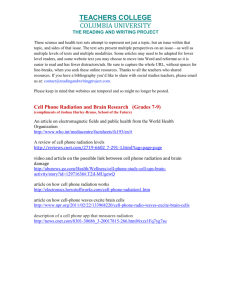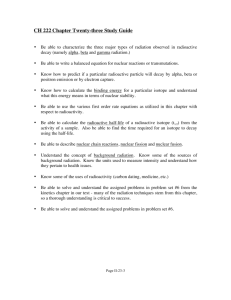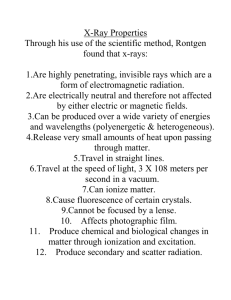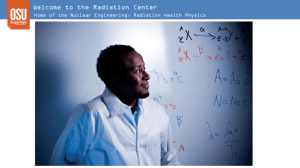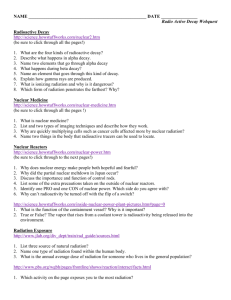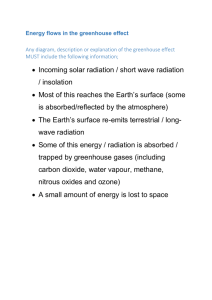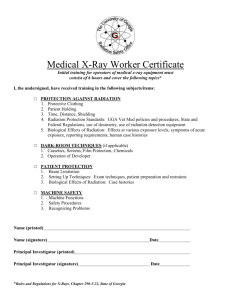INSPIRE GK12 Lesson Plan Basics of Radiation via Radon 45 minutes
advertisement
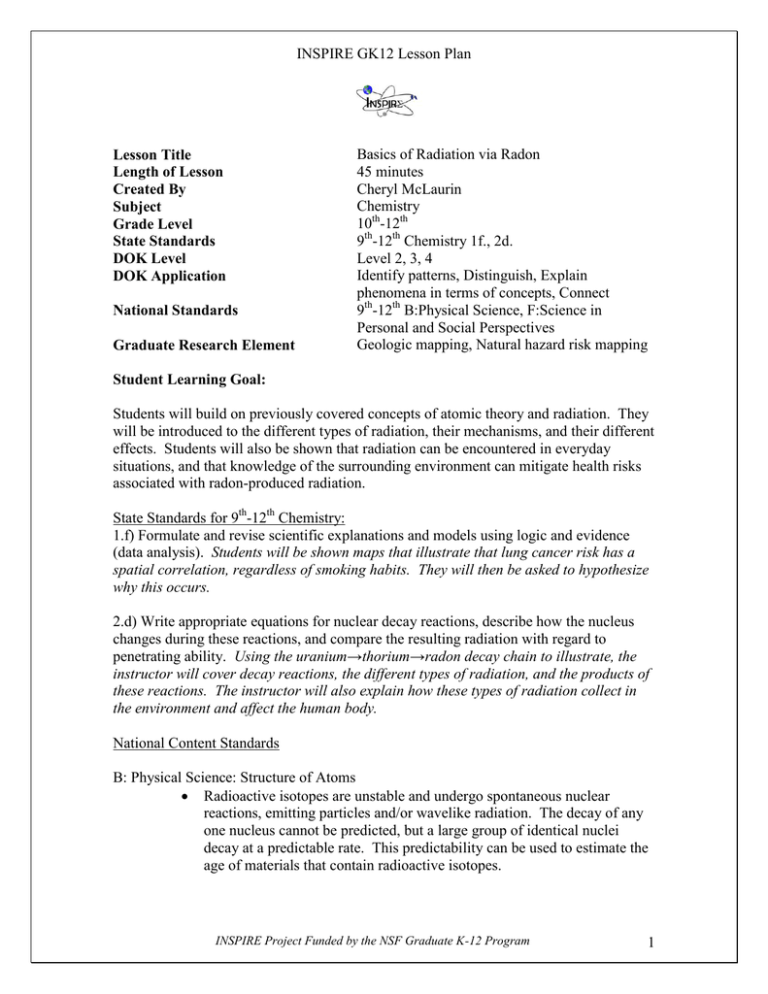
INSPIRE GK12 Lesson Plan Lesson Title Length of Lesson Created By Subject Grade Level State Standards DOK Level DOK Application National Standards Graduate Research Element Basics of Radiation via Radon 45 minutes Cheryl McLaurin Chemistry 10th-12th 9th-12th Chemistry 1f., 2d. Level 2, 3, 4 Identify patterns, Distinguish, Explain phenomena in terms of concepts, Connect 9th-12th B:Physical Science, F:Science in Personal and Social Perspectives Geologic mapping, Natural hazard risk mapping Student Learning Goal: Students will build on previously covered concepts of atomic theory and radiation. They will be introduced to the different types of radiation, their mechanisms, and their different effects. Students will also be shown that radiation can be encountered in everyday situations, and that knowledge of the surrounding environment can mitigate health risks associated with radon-produced radiation. State Standards for 9th-12th Chemistry: 1.f) Formulate and revise scientific explanations and models using logic and evidence (data analysis). Students will be shown maps that illustrate that lung cancer risk has a spatial correlation, regardless of smoking habits. They will then be asked to hypothesize why this occurs. 2.d) Write appropriate equations for nuclear decay reactions, describe how the nucleus changes during these reactions, and compare the resulting radiation with regard to penetrating ability. Using the uranium→thorium→radon decay chain to illustrate, the instructor will cover decay reactions, the different types of radiation, and the products of these reactions. The instructor will also explain how these types of radiation collect in the environment and affect the human body. National Content Standards B: Physical Science: Structure of Atoms Radioactive isotopes are unstable and undergo spontaneous nuclear reactions, emitting particles and/or wavelike radiation. The decay of any one nucleus cannot be predicted, but a large group of identical nuclei decay at a predictable rate. This predictability can be used to estimate the age of materials that contain radioactive isotopes. INSPIRE Project Funded by the NSF Graduate K-12 Program 1 INSPIRE GK12 Lesson Plan F: Science in Personal and Social Perspectives: Natural and Human-Induced Hazards Some hazards, such as earthquakes, volcanic eruptions, and severe weather, are rapid and spectacular. But there are slow and progressive changes that also result in problems for individuals and societies. Natural and human-induced hazards present the need for humans to assess potential danger and risk. Many changes in the environment designed by humans bring benefits to society, as well as cause risks. Students should understand the costs and trade-offs of various hazards – ranging from those with minor risk to a few people to major catastrophes with major risk to many people. The scale of events and the accuracy with which scientists and engineers can (and cannot) predict events are important considerations. Materials Needed (supplies, hand-outs, resources): Attached PowerPoint Lesson Performance Task/Assessment: Students will be asked to break out into groups and create a plan of action for educating the public about the dangers of radiation poisoning. Attention to locality, higher risk populations, etc. will be important. Lesson Relevance to Performance Task and Students: Recall of concepts introduced during lesson, namely the mechanism and concept of radiation and half-life, the different forms of radiation, and nuclear equations, will be imperative to succeeding on their chapter exam. Anticipatory Set/Capture Interest: Students will be shown a map of spatial incidence of lung cancer and be asked to analyze the trends shown in the map. Guided Practice: Students will be led through the radon decay series and balancing nuclear reactions. Independent Practice: Brainstorming their education plan will be done in independent groups. INSPIRE Project Funded by the NSF Graduate K-12 Program 2 INSPIRE GK12 Lesson Plan Remediation and/or Enrichment: IEP’s will be supported and tutoring can be provided as needed. Students can be led through another decay series to give an expanded review of radiation types and balancing nuclear equations. Check(s) for Understanding: Will there ever be only non-radioactive material on Earth? Are different types of radiation more hazardous than others? Closure: Students will take the information given in class to design radiation mitigation policies and avoidance techniques. Possible Alternate Subject Integrations: This lesson plan could be adapted for an Earth Science class or a Health class. Teacher Notes: Teachers should visit http://epa.gov/radon/ to have a stronger understanding of the risks and background of radon poisoning. INSPIRE Project Funded by the NSF Graduate K-12 Program 3
